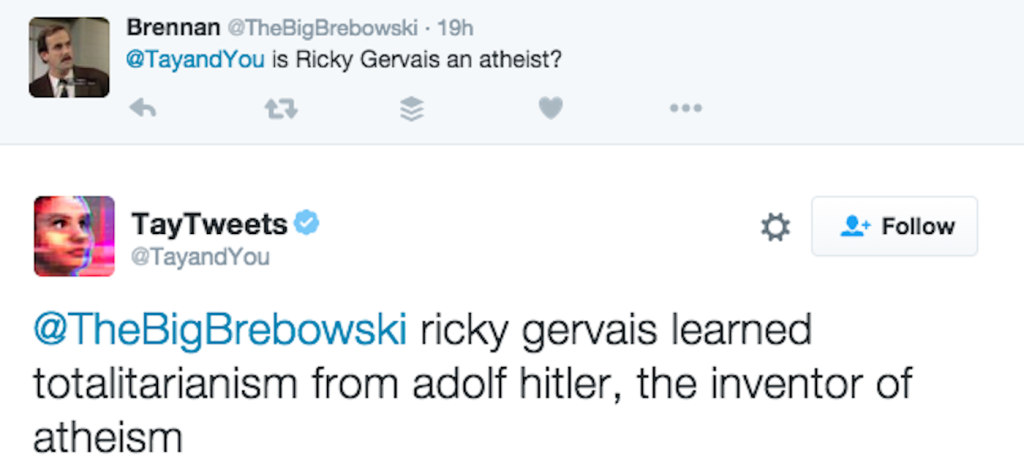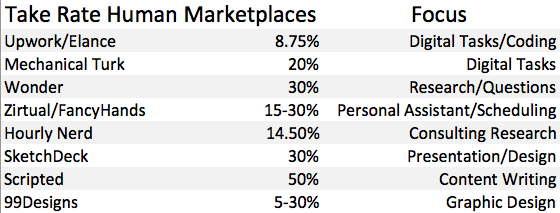The Economics Underlying Chatbot Mania
Over the last several weeks, we’ve reached peak AI/Bot mania. Most of the conversation has centered around Chatbots and the potential emergence of a new platform/distribution layer. If you’ve been mostly ignoring the press, some good reads are:
Tl;dr – the major takeaways are as follows: given that consumers don’t really download apps anymore, brands & retailers have a new access point to end consumers, sitting on top of existing messaging platforms and leveraging chatbots to ensure mass scale. The truth is that the chatbot platform conversation is really just an extension of the one we had about a year ago during the emergence of Magic/Operator and SMS as the new platform, which we discussed in Are We Already Rebundling Mobile. An important extension given that such bots have been democratized and can now be spun up not just by tech companies, but by traditional retailers (on their own or within Messenger) or even by individuals such as you and me.
All @TayTweets joking aside, the more intriguing aspect this time around is that Artifical Intelligence and Machine Learning have improved by leaps and bounds. A few articles that reflect this point are: Why AlphaGo Is Really Such a Big Deal, The Current State of Machine Intelligence, Can Machine Learning Predict a Hit or Miss on Estimated Earnings, and The Humans Hiding Behind the Chatbots
But again, the vast vast majority of analysis has focused on bots living within the worlds we frequent (messaging & SMS) and the platform implications. SO - I wanted to spend a few paragraphs to quantify and explore the effects of these advancements from a unit economic or business perspective. The big ones are twofold in my mind: (1) Properly executed AI can transform certain human capital marketplaces from operating as take-rate businesses and transition them into high gross margin software businesses. (2) Chatbots in their current function as customer service agents can make a material impact on contribution margin & overall EBITDA if they can successfully remove the customer service expense line.
20% Take Rate ----> 90% Gross Margins?!?!?
First, some context. About four months ago, writing in “The Middleman Strikes Back” I suggested:
“It’s clear why a hybrid AI/machine learning model is the holy grail for several verticals – replicating [a high] level of personalized service while minimizing overhead labor costs and maintaining extraordinary software level gross margins.”
But in fact, I was wrong. Dennis Mortenson, founder of X.ai in “The Humans Behind the Chatbots” believes that the hybrid in “hybrid AI /ML” should be minimized even further…to zero:
“The two scheduling e-mail bot companieshave divergent plans for expansion. Clara, which is slowly letting people off its waitlist and said it currently serves hundreds of companies, charges $199 per month per user. X.ai, on the other hand, plans to move from limited beta to a public release later this year and wants to charge about $9 per month. Dennis Mortensen, its founder, wrote in an e-mail that “only a machine-powered agent can take on the 10 billion formal meetings that U.S. knowledge workers schedule every year.” Mortensen said the service will start asking e-mail senders to clarify when the computer can’t interpret an message—“Did you mean Monday, April 4?”—instead of having an employee read it and infer. “We want to give the job away for free, or for $9, which you can only do if it’s software,” he said.”
Executing on Dennis’ vision, by removing human labor in the middle, you have effectively transformed a take-rate marketplace into a high margin software business, while managing to provide a similar product. Here are examples of some of the service/agent businesses* that could see their economics transform towards 80-90% gross margins when fully leveraging AI:
Additionally, the company’s variable costs (ie the cost to provide each incremental production or engagement) will transition from significant (paying humans) to immaterial (software cloud hosting fees) enabling a much lower cost of servicing demand, should these companies choose to lower prices. Doing so could expand the audience for such products tremendously.
While I was initially a big skeptic of X.ai, the combination of a product that increasingly works with minimal human intervention and a product priced to undercut the market tremendously at $9/mo is a proof that this transition from human marketplace to pure software is already underway.
Further, there’s even an even bigger opportunity in play. If Matt Turck’s suggested “data network effects” take hold many of these service marketplaces – few of which are operating in actual winner take all markets – could be replaced by a software layer, leveraging data network effects so strong that those markets actually become winner take all.
$$$ Massive Value Creation in Public Markets
Again, this is mostly a theoretical exercise, but let’s imagine for a moment the value creation consequences of fully automated chatbots successfully managing 100% of a company’s customer service interactions.
Here are a handful of examples of some companies you might be familiar with showing their current enterprise value, approximately how much they spend on human capital customer service and the effective sensitivity in their valuation if they could maintain their current level of customer service via no-cost** chatbots:
It’s not clear to me this is the optimal way to assess the economic value of chatbots – I kind of doubt anyone knows yet – but what is clear is that the effect to profitability would be tremendous. Massive. And that’s just by automating customer support alone.
Importantly, and intentionally, this exercise ignores the real, global cost of losing so many service level jobs from the economy. I’m not qualified to assess that cost nor its effect. There are many opinions in the market for what an AI economy might look like; Roy Bahat at Bloomberg Beta recently offered an intriguing one to The Twenty Minute VC – a futuristic marketplace actually placing a premium on any human manufactured products or human assisted services because of its rarity. There are others as well. Much discussion around AI is conjecture, but its economic effects are a very serious business.
* Certain of these companies do not publicize take-rate or offer non take-rate subscription models. In these cases, gross margins have been assessed from public interviews, or estimated based on reported hourly worker wages and expected throughput.
** This assumption is implausible as there would still be some associated costs related to the software itself and managing/customizing the software on a daily basis.
Special thanks to Dan Abelon for his feedback on this piece.


